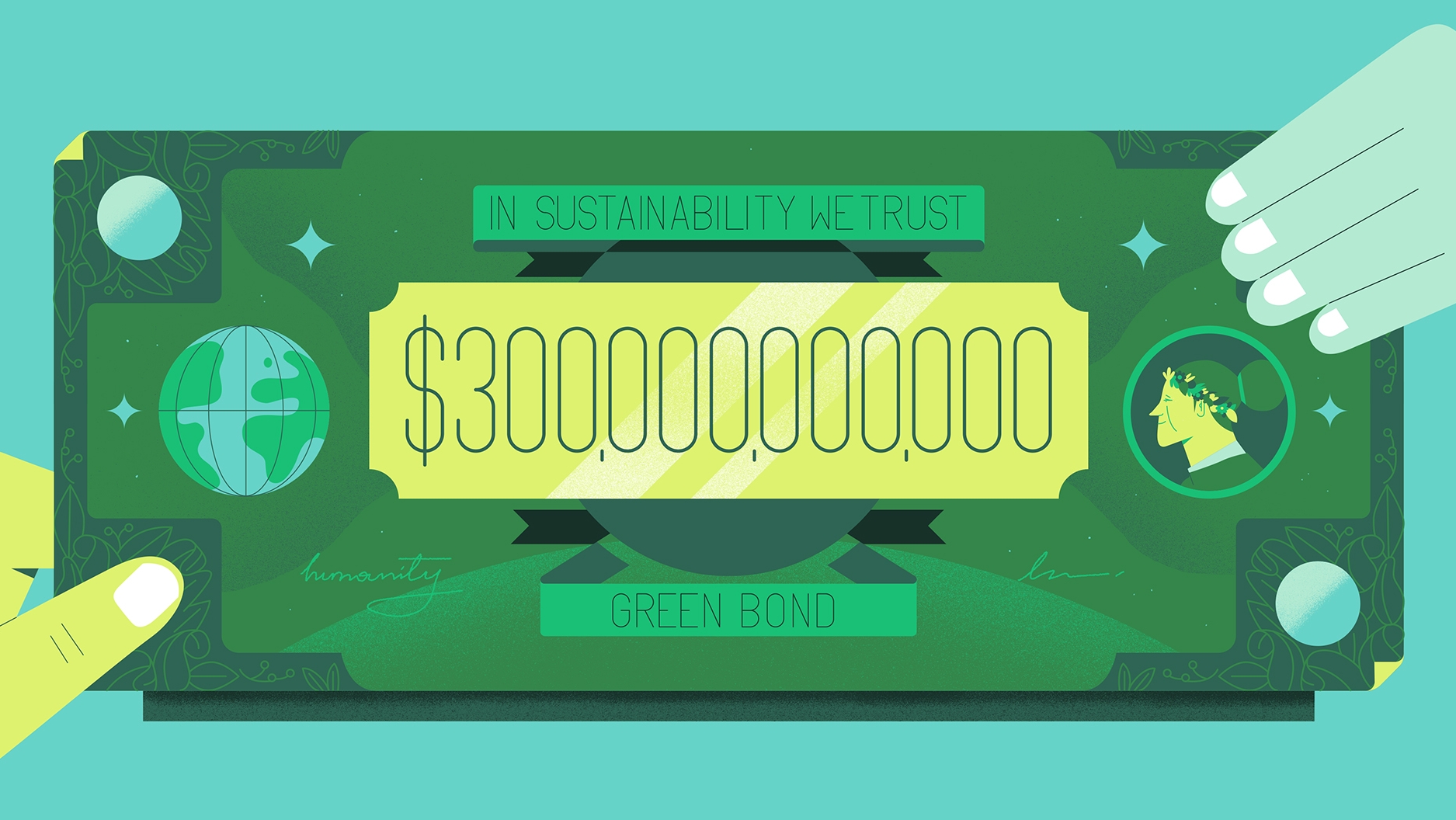
Illustration: Michał Bednarski
With much of the world taking tentative steps towards a semblance of normality in the wake of the coronavirus crisis, talk is inevitably turning to recovery. The challenge will be building a road back that does not come at the expense of tackling the real, long-term threat to humankind: climate disaster.
The property industry has a key part to play in meeting goals of reducing carbon emissions and improving energy consumption, as well as rethinking the way the world operates post-coronavirus. Thoughts are turning to green finance initiatives as a way of unlocking major infrastructure and development projects while protecting the environment.
Green bonds are one such financial instrument. They raise funds for new and existing projects that deliver environmental benefits, and a more sustainable economy. They are typically asset-linked and backed by the issuing entity's balance sheet, so they usually carry the same credit rating as their issuers’ other debt obligations.
Indeed, the EU Technical Expert Group on Sustainable Finance , of which RICS is a member, stressed the importance of the private sector’s role in ensuring access to finance that promotes a sustainable recovery in the months ahead.
“Corporate and investor strategies that only maintain existing approaches and environmental performance levels and do not clearly align with environmental objectives are accumulating financial risk and contributing to a future climate-related social disruption,” it said in a paper released in April. “Private sector plans must be transparent and clear on their alignment with the environmental and social objectives to increase the effective targeting of public recovery measures.”
Esther An is chief sustainability officer at City Developments, a Singapore-based listed property company that booked S$3.4bn (£1.9bn) in revenue last year. She believes the link between COVID-19 recovery measures and sustainable development is obvious. “Both the global pandemic and the climate emergency do a lot of harm to more vulnerable communities and to developing nations, so these are the communities that will need more help,” she says. “Whether that is directly linked to COVID-19 or not, sustainable financing or impact investing will be in demand.”
City Developments became the first company to issue a green bond in Singapore in 2017, valued at S$100m (£57m). It used the money to pay back the cost of making sustainability upgrades to its flagship Republic Plaza building, which had earned the development the highest possible rating in Singapore’s national green building certification scheme, the platinum award.
“I’d say green financing is an extension of our commitment to green building,” says An.
“I think we will see more corporates making use of green financing, for climate needs but also for social needs as well”

Rapid growth of green bonds
Globally, green bond investment has boomed in recent years. According to a report published earlier this year by Moody’s Investors Services, green bond issuance is set to hit $300bn in 2020.
The green bond market emerged in 2010. By 2019, bond issuance had grown to $255bn, funding projects that tackle issues as diverse as renewable energy, sustainable resource use and clean transportation. Regionally, European issuers accounted for nearly half of all green bonds in 2019, but the US is the world’s single largest market.
Part of the reason for this rapid growth is an appetite among investors to boost their sustainability credentials. It is something that Calvin Kwan, head of sustainability at Hong Kong-based Link REIT has particularly noticed in recent years. When Link REIT was looking to issue a green bond in 2015, Kwan says investors he met on a roadshow were putting together ESG-focused teams and asking questions about the company’s credentials.
“Fast-forward to 2019 or 2020 and they’re asking much more intricate questions,” he says. “They’re asking for more detail, down to the level of individual asset performance, how targets are set, whether we’ve met them and if not, why not. I’m finding with our investors that their ESG teams have probably grown the fastest over the past few years – even in a market where a lot of fund investors are losing their jobs.”
Focus on liquidity
Unsurprisingly, the early part of this year saw particularly volatile conditions in the bond market, says Keith Ng, director of finance at Link REIT, although conditions are beginning to stabilise, and there could be opportunities.
“People may find that the interest rate is so low that they may want to issue more debt as the overall macro environment favours that,” he says. “And there will be an increasing focus on liquidity: we don’t know whether the pandemic will rise up again so it is better to have more liquidity. So we have seen a lot of bond issuance, green and otherwise.”
Kwan says Link REIT has discussed the possibility of a “pandemic bond” with financial institutions, although he doesn’t think the phenomenon is here to stay.
“Unfortunately, you can’t really measure how you use the funding for critical pandemic responses,” he points out. “In the end it still goes towards funding things such as energy savings and human health and wellbeing aspects, which are part of broader sustainability goals. That said, I think we will see an increase in green financing specifically addressing that key area, because health and wellbeing will be a part of the new normal moving forward.”
In the early weeks of the pandemic, governments and businesses were rightly focused on managing the impact of the virus itself, and there were concerns that green issues would slip down the agenda. But this doesn’t seem to have happened, according to Emma Harvey, programme director at the London-based Green Finance Institute (GFI). “What [the pandemic] has done is shown that governments and organisations can move at lightning pace to bring in new financial products and new solutions,” she explains. “If anything it’s brought the need for the green economic recovery – helping society but also helping our planet – to the fore.”
Members of the GFI’s coalition for energy efficiency in buildings regard the past few months as a “temporary pause” rather than a change in direction, she adds. “They are still committed to addressing the climate topic and using their financial clout to be able to do that. I think it has pushed it up the agenda and helped push green finance onto the road of becoming fully mainstream.”
“The pandemic has pushed green finance onto the road to becoming fully mainstream” Emma Harvey, Green Finance Institute
Social bonds may also increase in popularity during the recovery period as borrowers seek to link societal outcomes to finance. One of the GFI’s members is developing a municipal bond that can be issued by a local authority and then invested in by retail investors.
“We’ve seen COVID-19 really galvanise community spirit, so if you knew that your local council was issuing a bond to undertake green projects in your area, and you as a retail investor could invest in it, it could kickstart a really interesting movement of community-led green activity and investment,” believes Harvey.
Regulating the green bond market
But with increasing usage comes an increasing need for regulation. Governments and regulators, particularly in Europe, are increasingly focused on providing structure and clarity to the sustainable finance market in order to ensure that it continues to be used for its intended purposes.
RICS was on the working group that developed an “EU taxonomy", adopted by the EU Council in April. The taxonomy provides businesses and investors with a common language to identify economic activities that are considered environmentally sustainable. The hope is that the taxonomy will help investors to focus their activities on the most sustainable technologies and businesses. The implications for the green finance market are evident: the taxonomy can go some way in helping investors identify which bonds offer the clearest green solutions.
Harvey said the guidelines have been broadly welcomed. “We’re starting to hear that it is increasingly being adopted in the US, China and globally,” she says. “It has its critics but it’s the most comprehensive view of what sustainability is, drawn up by a very reputable body.
“I think these kinds of interventions are very valuable; informing and guiding the market is very valuable to ensure that it maintains its rigor over the long term.”
However, she adds that there is a risk that, if regulation is introduced too early, it could stymie the market before it has a chance to become established. “There is a role for regulation, but it should be done in a well-considered manner that doesn’t stop the market from flourishing.”
For Mirko Käppeli, chief financial officer at Swiss developer Zug Estates, a bond assessment process that took in the whole company would be preferable to one that focuses on the particular project or initiative it is intended to finance. Zug Estates issued its first green bond, and the first in Switzerland, worth CHF100m (£84m) in 2019.
“It would be possible for a company mining greenhouse gas-emitting materials that is building a green headquarters to issue a green bond to fund it,” he points out. “We would prefer the process require borrowers to measure themselves against their peers using some fixed output metrics, so we could say, for example, that company A produces this many kilograms of CO2 per kilometre of retail compared with company B. I get the impression that there are still quite a lot of companies who talk about sustainability and have input measures but don’t really focus on the output.”
“It would be possible for a company mining greenhouse gas-emitting materials that is building a green headquarters to issue a green bond to fund it” Mirko Käppeli, Zug Estates
He isn’t convinced the EU taxonomy will solve the market’s problems. “In an ideal world the market would regulate itself, and we would lean towards green finance because of pressure from the market and investors to be more green,” he says. “I hope that will ultimately be stronger than government regulations.”
Green loans: the alternative to bonds
And after a blistering few years, there are signs that the bond market is beginning to slow, ceding some ground to newer, sustainability-linked loans, which arguably have looser requirements.
Sustainability-linked loans have the advantage of being accessible to companies that might not have otherwise qualified for green bonds. As a result, Esther An thinks these types of loans might have a key part to play in the post-COVID-19 recovery period.
Last year, City Developments secured a S$250m revolving credit facility from Singaporean bank DBS called a sustainable development goal (SDG) innovation loan. This sustainability-linked loan was the first of its kind in that it was intended to accelerate the development of innovative solutions that have a positive impact on the United Nations’ SDGs. The company is eligible for a discount on the interest rate of the loan when it achieves sustainability-related performance targets.
“It is basically adopting green bond principles but we’re connecting it to innovation,” explains An. “Both the pandemic and climate change are accelerating needs such as access to food, clean water, medical help – and all of these link to SDGs, so would qualify for this sort of sustainable financing, whether that’s a bond or a loan. I think we will see more corporates making use of green financing, for climate needs but also for social needs as well.”
Fears that the pandemic might have eclipsed the climate crisis seem to have been misplaced. But governments are keen to ensure that the recovery is sustainable, for both people and the planet.
